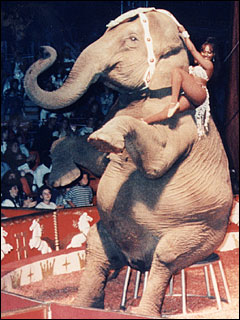Circuses and Zoos are crimes against wildlife
Tuesday, May 1st, 2012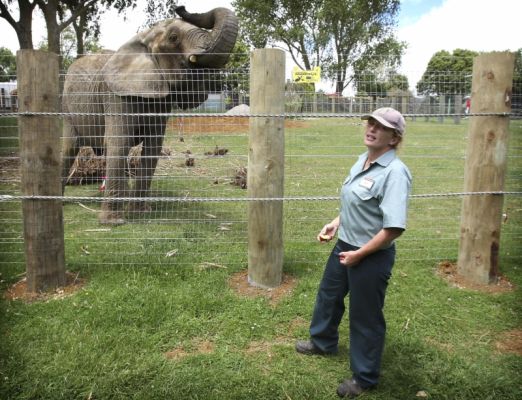 African Elephant at Franklin Zoo & Wildlife Sanctuary
situated outside the town of Tuakau near Auckland, New Zealand.
Its wildlife veterinarian surgeon (the late) Dr. Helen Schofield stands in front.
[Ed. Note elephant’s tusks have been previously sawn off by a circus]
African Elephant at Franklin Zoo & Wildlife Sanctuary
situated outside the town of Tuakau near Auckland, New Zealand.
Its wildlife veterinarian surgeon (the late) Dr. Helen Schofield stands in front.
[Ed. Note elephant’s tusks have been previously sawn off by a circus](Photo by Associated Press, 20091220) [Source: ^http://www.newsday.com/news/nation/ca-sanctuary-says-killer-elephant-still-welcome-1.3684690]
.
Last Wednesday afternoon (20120425) New Zealand wildlife veterinarian surgeon, Dr. Helen Schofield, was tragically crushed to death by an African Elephant who sat on her at Franklin Zoo & Wildlife Sanctuary near Auckland, according to emergency officials and reports.
Reports say the female elephant was trying to protect the vet after the elephant got a fright and wrapped her trunk around the vet, before going down, killing the vet. [Ed. This suggests that it was an accident caused by fright, and not the intention of the elephant to kill the vet]. Emergency services say the woman died at the zoo/sanctuary at around 4.30pm local time.
What is significant is that this 39-year-old African elephant was formerly used and abused in circus entertainment (Loritz as well as Webers), where she had lived shackled for 28 years with no other elephants. The circus had not surprisingly named the elephant ‘Jumbo‘.
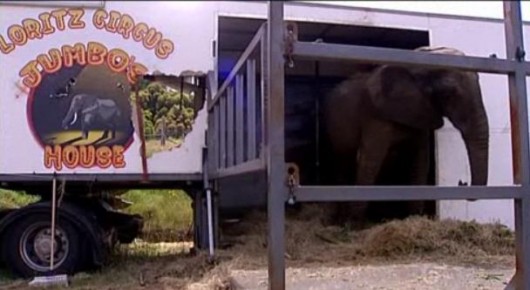 Same elephant back in 2009, named ‘Jumbo’, tethered to Loritz Circus trailer for 28 years
African elephants in the wild live up to 70 years, but in captivity only to 50, not surprisingly.
[Watch Video at Webber’s Circus in 2009].
Same elephant back in 2009, named ‘Jumbo’, tethered to Loritz Circus trailer for 28 years
African elephants in the wild live up to 70 years, but in captivity only to 50, not surprisingly.
[Watch Video at Webber’s Circus in 2009].
.
About three years ago, the elephant was given to the SPCA Auckland (Society for the Prevention Against Cruelty to Animals, ^http://www.spca.org.nz/) which then found a refuge for it in 2009 at the Franklin Zoo and Wildlife Sanctuary just outside Auckland. The elephant has for the past three years been under the care and rehabilitation at the zoo/sanctuary.
Dr Schofield at Franklin had previously stated that the elephant (renamed by the zoo ‘Mila‘) had settled in well and developed close and affectionate relationships with her team of keepers. She wrote: “Our dream for Jumbo is to get her in a situation where she can have other African elephants for company.”
A woman who lives in a property neighbouring the zoo, who declined to be named, said she had seen the activity at the zoo when the ambulances arrived.
“We look out and see the elephant every day,” she said. “I don’t think it’s very friendly. It hasn’t had a very happy life.”
Same elephant in 2009SAFE (Save Animals from Exploitation, NZ) animal rights protest group stage a protest outside the circus at Avalon Park, Lower Hutt, New Zealand
[Source: ‘Loritz Circus Jumbo the Elephant’, YouTube, ^http://www.youtube.com/watch?v=u5c00551DUw]
.
Sad circus scenes only three years ago (different elephants)[Source: ‘Jumbo Stars: Elephants in Carson & Barnes Circus’, YouTube, ^http://www.youtube.com/watch?feature=endscreen&NR=1&v=jX58pNwWcRY]
.
New Zealand Police have stated that if the death is confirmed as an accident it is unlikely the elephant will be put down, but a final decision will be made in 24 hours. At the time of writing six days hence, the elephant is still alive and under care at the nearby Auckland Zoo (^http://www.aucklandzoo.co.nz/) awaiting her fate.
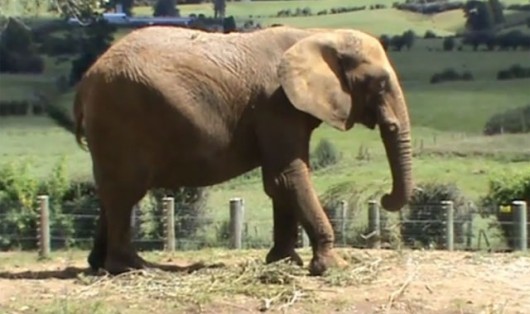 Same African Elephant, renamed ‘Mila’
Elephants are social creatures and there was concern Mila had been lonely.
Mila was the only elephant at the Franklin Zoo, which built a new enclosure for her in 2010.
Same African Elephant, renamed ‘Mila’
Elephants are social creatures and there was concern Mila had been lonely.
Mila was the only elephant at the Franklin Zoo, which built a new enclosure for her in 2010.(Photo Franklin Zoo/Sanctuary)
.
[Sources: ‘Vet killed by elephant at Franklin Zoo‘, 3 News (NZ), 20120425, ^http://www.3news.co.nz/Vet-killed-by-elephant-at-Franklin-Zoo/tabid/423/articleID/251805/Default.aspx; ‘Zoo Keeper Crushed To Death By Elephant‘, 20120425, Sky News (UK), ^http://news.sky.com/home/world-news/article/16215812; ‘Elephant kills keeper at Franklin Zoo‘, 20120425, Waikato Times (NZ), ^http://www.stuff.co.nz/waikato-times/news/6806389/Elephant-kills-keeper-at-Franklin-Zoo].
Franklin Zoo and Wildlife Sanctuary was nearing the end of a two year preparatory re-adjustment process for the elephant to have her ultimately crate shipped to California (USA) to Pat Derby’s Performing Animal Welfare Society (PAWS) ^http://www.pawsweb.org/ in San Andreas outside Sacramento. Since 1984, The Performing Animal Welfare Society has provided a sanctuary for animals that have been the victims of the exotic and performing animal trades. PAWS also investigates reports of abused performing and exotic animals, documents cruelty and assists in investigations and prosecutions by regulatory agencies to alleviate the suffering of captive wildlife.
Despite the tragic accidental killing of Dr Schofield, Pat Derby has confirmed that it remains committed to receiving the elephant into its Californian sanctuary.
Hans Kriek, executive director of New Zealand based Save Animals from Exploitation ^http://www.safe.org.nz/, said he had talked to Dr Schofield the day before she died and that she told him she believed Mila was ready to ship.
.
Pat Derby advised her experience with elephants rescued from circuses:
“All elephants, particularly Africans, suffer from Post-Traumatic Stress Disorder (Ed. like humans).
“They’re captured from the wild. The capture usually involves killing their whole family unit, which is a terrible drama.
They all suffer horrendous physical and psychological problems. You just never know when it will express itself.”
In addition, Derby said she is sure the stress of circus life contributed to the trauma of adjusting for Mila.
.
In San Andreas, near Sacramento in Northern California, where Mila was headed, three African elephants are kept separate from other elephants, Derby said.
“We always keep safe distances and safety barriers between the elephants and the people so there’s no opportunity for accidents to happen“, she said.
.
Elephant Shipment Trauma
.
Transporting an elephant halfway around the world is extremely tricky, Derby said. Flying is the fastest way but also the most expensive and “I don’t know what the funding issue is there,” Derby said.
If a ship and truck are used, it’s a “long, long journey,” she said. Once an elephant leaves on such a trip, it is stuck in the crate until it arrives, she said.
[Source: ‘CA sanctuary says killer elephant still welcome‘, by Sue Manning and Nick Perry, Associated Press, 20120427, ^http://www.ktre.com/story/17796646/calif-sanctuary-say-killer-elephant-still-welcome].
Wildlife for Entertainment is Immoral
.
“When children see animals in a circus, they learn that animals exist for our amusement. Quite apart from the cruelty involved in training and confining these animals, the whole idea that we should enjoy the humiliating spectacle of an elephant or lion made to perform circus tricks shows a lack of respect for the animals as individuals”
~ Peter Singer, Author/Philosopher, Professor of Bioethics at Princeton University, USA
.
Animal abuse and cruelty is immoral. Most modern civilized societies have outlawed animal cruelty, making it a crime.
Entertainment involving animals is a form of animal abuse. Circuses and zoos conceived for human entertainment are primitive and barbaric, dating back to 18th Century Georgian times when human slavery was cultiraly acceptable. The first modern zoo evolved out of an aristocratic menagerie in Vienna in 1765.
Although many circuses have been banned from using wildlife in their entertainment, disgustingly it has only been in recent years. But still, organisations such as Sea World (^http://www.sea-world.com.au/) still entertain the public using dolphins, seals and orcas.
Jumbo was the last of New Zealand’s circus elephants, retired in 2009 after a concerted pressure campaign by Save Animals from Exploitation (SAFE), and there are no more circuses that use wild animals in this country. But the practice has still not been banned outright. This puts it in the category of anachronistic laws which should be repealed at the earliest opportunity.
In New Zealand, Dunedin and Wellington City Councils have local bans on the use of wild animals in circuses. There is a Circus Welfare Code, but like many of the codes under the Animal Welfare Act 1999 appears to contravene the Act under which it was created, particularly section 4(c) which stipulates that animals must have the ‘opportunity to display normal patterns of behaviour.’ A requirement that is by definition outside the performance expected of a circus animal.
[Source: ‘Circus Animal Bans’, by Vernon Tava, 20110209, The Solution (NZ), ^http://thesolution.org.nz/2011/02/09/circus-animal-bans/].
The plight of elephants in circuses is particularly troubling. Elephants are majestic creatures who are intelligent and self-aware. They are among the most socially- bonded animals on the planet, and display a complex array of emotions, including expressions of grief and compassion. They mourn their dead, use tools, and communicate with each other over vast distances through sound. They are biologically designed to browse, constantly on the move for 18 or more hours out of the day, even where food is readily available…
But enslaved in circuses, far removed from conditions they need to thrive, elephants:
- Spend days at a time chained in cramped train cars or trucks, eating and sleeping in their own excrement, exposed to temperature extremes, for much of their lives. When not in transit, they are chained or confined in tiny pens, usually on concrete.
- Perform unnatural tricks that are often damaging to their bodies. Wild elephants do not stand on their heads or on two legs.
- Often display neurotic behavior, such as swaying and head-bobbing, from boredom and severe stress (Ed. like Jumbo in the video above).
- Suffer from painful foot and joint disease, a leading cause of premature death in captive elephants, from standing too long on hard surfaces and in their own waste.
.
Circuses Tear Families Apart
.
Elephants have intense, strong family bonds. Wild females stay with their mothers, aunts and cousins for life. Males do not leave the herd until their teens. The entire extended elephant family helps nurture and care for the young.
Most of the elephants performing in circuses today were captured from the wild, violently separated from their mothers, and shipped to the U.S. when they were very young. Every Asian elephant taken from the wild has endured a brutal breaking process (“the crush”), which involves beating with nail-studded sticks, sleep-deprivation, hunger, and thirst to break the animals’ spirits.
Elephants born into captivity in circuses are routinely torn from their mothers as infants younger than two years old, for training and performance.
For anyone who knows about elephants, seeing these complex, family-centered individuals chained and broken, performing demeaning tricks is simply heartbreaking…
There’s no family fun to be had at an event that involves such cruelty and suffering. Let’s teach our children to respect animals by seeing them in their natural states, not as captives forced and beaten into unnatural displays for our entertainment.
.
“We can see quite plainly that our present civilization is built on the exploitation of animals, just as past civilisations were built on the exploitation of slaves”
~ Donald Watson
.
[Source: ‘Plight Of The Circus Elephant’ , ^http://www.nonhumanslavery.com/plight-of-the-circus-elephant-excerpt-from-idas-elephant-life-in-us-circuses].
As of 1 July 2010, the use of any animal in a circus has been banned in Bolivia. A handful of other countries have banned the use of wild animals in circuses but only Bolivia has banned exploitation of domestic animals in circuses as well.
The Bolivian law, which states that the use of all animals in circuses ‘constitutes an act of cruelty’ was enacted on 1 July 2009, with operators given a year to comply.
The bill took two years to pass through both chambers of the Plurinational Assembly, meeting stiff opposition from the eastern states of Bolivia where there was concern that the law would be expanded to include bullfighting, which is popular in rural villages. Bullfighting remains legal in Bolivia.
The legislature were eventually won over by a screening of videos shot by undercover circus infiltrators in Bolivia, Peru, Ecuador and Colombia co-ordinated and funded by Animal Defence International (ADI), a London-based NGO which found that ill-treatment and violence against animals in circuses is commonplace.
The harsh Bolivian climate alone claimed has claimed many victims. Just last year, a hippopotamus died in his sleep when the circus pool froze over in the Andean city of Potosí, 4000 metres above sea level. A dwarf elephant died of exposure in La Paz’s dry winter of 2007.
The follow-up to this law change is also important; with a number of wild animals no longer economically useful to their owners, many will be either killed or turned loose. Animals released from captivity generally do not re-integrate and are likely to die from starvation or attack from other animals. To avoid this, Ximena Flores, sponsor of the law, has said that “[a]bout 50 animals are circulating in national and international circuses at the moment [in Bolivia] and we want to negotiate to make sure that the animals aren’t eliminated.”
Austria, Costa Rica, Hungary, Finland, India, Israel, Singapore and most recently China have banned the use of wild circus animals while Denmark, Sweden, Finland, and the Czech Republic have limited the use of certain species. The State of Rio de Janeiro in Brazil and the cities of Buenos Aires (Argentina) and Porto Alegre (Brazil) have implemented full bans on both wild and domesticated species. Nationwide bans on all animals in traveling circuses are under consideration in Brazil, Colombia and Peru, where legislation is expected in the near future. Several major European towns and cities have either banned all circus animal acts or wild animal acts, including Thessaloniki (Greece), Barcelona (Spain), Cork (Ireland) and Venice (Italy). In Croatia, most major cities have bans.
.
Australia
.
In Australia, Ipswich Council (Queensland) and Parramatta (Sydney, NSW) have local bans of wild animals in circuses.
Around the world, the plight of animals in circuses is increasingly heard. National, regional and local governments in at least 30 countries have already banned the use of exotic or all animals in circuses. But the Australian Federal and State Government policies are failing these animals. The requirements in the — mostly voluntary — guidelines for the keeping of animals in circuses in Australia are far below what is generally required for the same species kept in zoos and are totally inadequate to protect their welfare. Thankfully an increasing number of Australian councils are taking an ethical stance by adopting a ban on exotic animal circuses on council land.
For Animals Australia, entertainment stops where animal suffering begins. Circuses can not recreate a natural environment nor can animals in circuses perform much natural behaviour. A non-domesticated animal’s life is consequently impoverished and the keeping of exotic animals in circuses should therefore be banned. The animals currently being kept by circuses need to be re-homed in a quality sanctuary or zoo.
.
Britain
.
Currently, Britain appears to be at at a critical juncture with regard to banning the use of performing wild animals. A ban in the UK would affect around 40 animals owned by four circus companies. On 25 March 2010, Labour’s environment minister, Jim Fitzpatrick, said he was “minded” to ban performing wild animals after research showed that 94 per cent of the public supported a ban. A survey by the Animals Defenders International (^http://www.ad-international.org/adi_uk/) of 310 local authorities (town and county councils) showed that 39% had already banned all animal acts and 17% had banned wild animal acts.
However, while the new Coalition government has said it is considering whether or not to proceed with the ban, 143 politicians have now signed a parliamentary Early Day Motion, (EDM) 403, calling for the wild animal ban to finally be implemented.
[Sources: ‘Circus Animal Bans’, by Vernon Tava, 20110209, ^http://thesolution.org.nz/2011/02/09/circus-animal-bans/, Circuses, Animals Australia, ^http://www.animalsaustralia.org/issues/circuses.php].
Animal Suffering
.
Exotic animals in circuses are routinely subjected to months on the road confined in small, barren cages. These animals are forced to live in enclosures denying them every opportunity to express their natural behaviour and their training is often based on fear and punishment as revealed by numerous undercover investigations.
As circuses play no meaningful role in education or conservation, the lifelong suffering of these animals continues only for the sake of a few minutes of entertainment.
Below: How do you get a wild animal to perform unnatural circus tricks?
This shocking undercover footage from the U.S. shows Carson & Barnes ‘trainers’ using bull hooks, electric prods, and even blowtorches on their elephants. Footage thanks to PETA (People for the Ethical Treatment of Animals, ^http://www.peta.org/). ^http://www.animalsaustralia.org/issues/circuses.php
[WARNING: MAY DISTURB, CONTAINS COURSE LANGUAGE]
How United States Carson and Barnes get elephants to do ‘tricks’ for cirus entertainment ^More videos from Animals Australia.
Circuses in 2012
‘Wild animals in circuses WILL be banned after ministers cave in to demands to launch crackdown’, by Kirsty Walker, UK, 20120301, ^http://www.dailymail.co.uk/news/article-2108504/Wild-animals-circuses-WILL-banned-ministers-cave-demands-launch-crackdown.html]
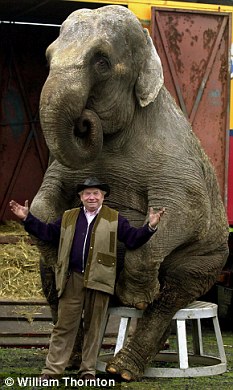 Saved by the Mail: Anne the elephant, pictured with former owner Bobby Roberts, who along with his wife Moira has been charged with causing the animal suffering
Saved by the Mail: Anne the elephant, pictured with former owner Bobby Roberts, who along with his wife Moira has been charged with causing the animal suffering
.
Circuses will be banned from keeping wild animals within two years. Ministers will today announce the U-turn after coming under intense pressure from MPs and celebrities to implement the crackdown. The Department for the Environment will confirm plans to introduce a law within this Parliament.
Last year, MPs inflicted a humiliating defeat on the Government by backing a backbench motion by Tory MP Mark Pritchard, which called for a ban.
Until this is introduced, ministers will bring in a tough licensing regime for the few circus owners still using wild animals.
An estimated 150 to 200 animals are currently held in circuses, 37 of which are wild. They include zebras, lions, tigers, camels, a kangaroo and crocodiles.
Sir Paul McCartney, comedian Ricky Gervais and actor Brian Blessed are among the celebrities who have called for a ban, which 94 per cent of the public supports.
The Daily Mail has been at the forefront of the campaign after highlighting the plight of Anne, Britain’s last circus elephant.
Former owners Moira and Bobby Roberts have been charged with causing Anne suffering by failing to prevent her groom beating her.
The 59-year-old elephant now lives at Longleat safari park in Wiltshire thanks to our readers, who donated £340,000 for her care.
The prosecution is believed to be the first of a circus owner for animal cruelty under the Animal Welfare Act 2006.
An estimated 150-200 animals are currently held in circuses, and an estimated 37 of these are wild animals. These include zebras, lions, snakes, tigers, camels, a kangaroo and crocodiles.
Prime Minister David Cameron has previously signalled his support for the crackdown by acknowledging that it was ‘not right’ to still have lions and tigers performing in the big top.
A Defra spokesman said: ‘We always said we were minded to ban wild animals performing in travelling circus, the only issue being that we have to be sure that it cannot be overturned legally. ‘Therefore in the meantime we are proposing a tough new licensing regime which can be introduced quickly, to ensure high welfare standards.’
.
Entertainment Zoos or Wildlife Sanctuaries?
.
Removal of wild animals from their habitat is wrong. They should be left in their natural surroundings and not exploited as objects for human entertainment.
In situ wildlife refuges or wildlife sanctuaries play a critical role in habouring wildlife at risk from poaching and from the many human drivers of extinction. Wildlife refuges or wildlife sanctuaries situated in the native country of origin are best placed to enable wildlife to survive naturally. Zoological captive breeding programmes that facilitate wildlife reintroduction into the wild in safe sanctuaries are to be commended. This is where the resourcing, efforts and research need to be channelled globally.
But shipping wildlife over long distances to foreign and typically urban zoos, benefits human entertainment not the wildlife. Elephants belong in Africa or Asia according to their supbspecies, not in New Zealand. Petting zoos that encourage the public to get up and close with the animals are a mere extension of circuses – wildlife for human entertainment and as tourist drawcards/attractions.
.
Compare the Old Urban Entertainment Zoos:
.
Example 1: Auckland Zoo
The Tourist child spiel:
‘Auckland Zoo is home to the largest collection of native and exotic animals in New Zealand, set in 17 hectares of lush parkland and just five minutes from central Auckland. There is lots to see and do all year, including events, animal encounters, Zoom (behind the scenes) tours and more! Our Zoom (behind-the-scenes) Tours offer you an exclusive backstage pass to go behind the scenes. Imagine helping a keeper wash down an elephant, coming eye to eye with New Zealand fauna, a tiger, or one of Africa’s big five.’^http://www.aucklandzoo.co.nz/
.
Example 2: Taronga Zoo (Sydney, Australia)
‘Function and Venue Hire: ‘With 180 degree, uninterrupted views of Sydney Harbour, Taronga Zoo provides a picturesque backdrop and unique setting that is guaranteed to make any event truly memorable. With a wide a variety of venue options available, both in and outdoors,Taronga Zoo is an ideal setting for all occasions ranging from gala dinners, conferences, Christmas and cocktail parties as well as boasting a truly stunning venue for Weddings.The Taronga were the proud winners of the 2010 Restaurant and Catering Awards for Excellence -Wedding Caterer in a Function Centre AND voted in the Vogue Top 3 wedding locations 2012. With both these outstanding recognitions for excellence, the Taronga centre combining their passion and enthusiasm for food and their excellence in service and events is certainly an ideal choice to host your next event.’.
..with the In Situ Wildlife Sanctuaries:
.
Example 3: Orokonui Ecosanctuary (Waitati, Dunedin, New Zealand)
‘What began as a mere dream to restore an entire forest ecosystem to its pre-human state, is now a reality.
In less than 10 years, the Orokonui Ecosanctuary has become the only place on mainland South Island of New Zealand where native birds, animals and insects can live a life safe from predators. They are free to fly, feed, mate and nest wherever they wish, exactly as they would in the wild.
Since the $2.2 million, 8.7km pest-proof fence was erected around our 307 hectares of protected habitat in 2007, pests have been almost entirely eradicated. This has allowed us to reintroduce a number of endangered species and there are encouraging signs they are adapting well to their new home. In fact, it is becoming increasingly common for native birds to find their own way to the ecosanctuary and take up residence.
To support the Ecosanctuary, a multi-million dollar eco-friendly visitor and ODT education centre has been built into the hillside above Blueskin Bay. Here, visitors can learn about the Ecosanctuary and the native species it contains, take a guided tour through the Ecosanctuary, purchase gifts and educational material from the souvenir shop, or simply have a coffee and enjoy the view. All of the funds generated from visitors contribute to the ongoing conservation work at Orokonui Ecosanctuary.’
Example 4: Enkosini Wildlife Sanctuary (Northern Provence, South Africa
‘The Enkosini Wildlife Reserve was formed in 2001 to protect and preserve Africa’s wildlife and habitat. Enkosini (derived from the Zulu word meaning “place of kings”) was established as a conservancy, by purchasing and joining together large South African farms with the aim of restoring the environment back to its natural state and establishing a larger reserve for the benefit of African wildlife. Enkosini is a unique conservation initiative that will re-introduce indigenous wildlife onto land they once naturally roamed, ultimately re-establishing all of the original flora and fauna to the area. Enkosini will also continue to acquire habitat for the long-term survival of the wildlife and the preservation of their eco-systems.
Enkosini’s goal is to create a self-sustaining model of responsible conservation that preserves Africa’s natural heritage (habitat and wildlife); enhances the South African economy through overseas capital infusion, local and international eco-tourism, and job creation; and promotes education and awareness of conservation issues.’
^http://www.enkosiniecoexperience.com/EnkosiniWildlifeSanctuary.htm
